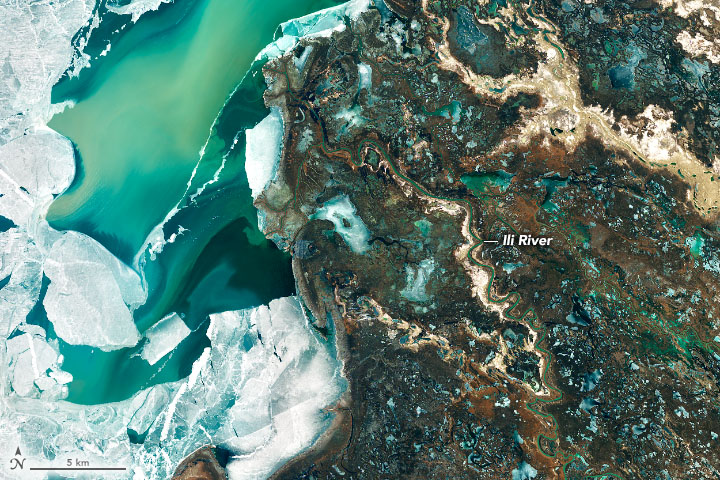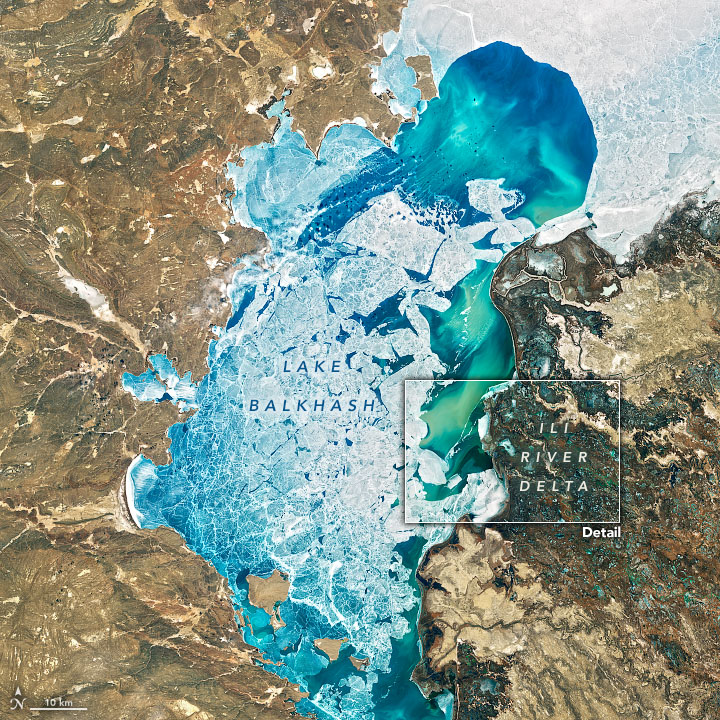
A Delta Oasis in Southeastern Kazakhstan
Downloads
- ili_oli_2020067.jpg (720x480, JPEG)
- balkhash_oli_2020067_lrg.jpg (4198x4198, JPEG)
Metadata
- Sensor(s):
- Landsat 8 - OLI
- Data Date: March 7, 2020
- Visualization Date: April 7, 2020
Seen from space, the Ili River Delta contrasts sharply with the beige deserts of southeastern Kazakhstan.
When the Operational Land Imager (OLI) on Landsat 8 acquired this natural-color image on March 7, 2020, the delta was just starting to shake off the chill of winter. While many of the delta’s lakes and ponds were still frozen, the ice on Lake Balkhash was breaking up, revealing swirls of sediment and the shallow, sandy bed of the western part of the lake. Over the deeper eastern part of the lake, ice persisted until the last week of March.
Most of the water in Lake Balkhash comes from the Ili River, which pours in through the southeastern shore. The expansive delta and estuary—still dark brown in this image thanks to Central Asia’s harsh winters—is nevertheless an oasis for life year round. Hundreds of plant and animal species make a home here, including dozens that are threatened or endangered.
Wild boars, gazelles, marbled polecats, and several other mammals roam the reed beds, meadows, and occasional forests. Dozens of fish species live or spawn in the lake and in the delta’s mosaic of streams and ponds, including ship sturgeon and wels catfish. Several species of jumping rodents—such as jerboas, voles, and gerbils—scurry amidst the underbrush. Millions of birds, including massive Dalmatian pelicans and endangered white-headed ducks, make use of these wetlands.
In 2012, Kazakhstan declared the delta a wetland of international importance under the Ramsar Convention, a treaty that encourages the conservation and sustainable use of wetlands throughout the world. But with significant amounts of the Ili River’s water being diverted for dams and irrigation, some observers say that the delta could become vulnerable to the same sort of environmental problems faced by wetlands near the Aral Sea, which has shrunk rapidly in recent decades.
References
- Encyclopedia Britannica Lake Balkhash. Accessed April 6, 2020.
- Imentai, A. et al. (2015) Vegetation, fauna, and biodiversity of the Ile Delta and southern Lake Balkhash — A review. Journal of Great Lakes Research, 41 (3), 688-696.
- Isbekov, K. et al. (2019) Impacts of water level changes in the fauna, flora and physical properties over the Balkhash Lake watershed. Lakes and Reservoirs, 24 (2), 195-208.
- NASA Earth Observatory (2017, November 4) Lake Balkhash. Accessed April 6, 2020.
- NASA Earth Observatory (2018, March 25) Lake Balkhash Under the Moon. Accessed April 6, 2020.
- Thevs, N. et al. (2017) Assessment of ecosystem services of the wetlands in the Ili River Delta, Kazakhstan. Environmental Earth Sciences, 76, 30.
- IISD (2012, October 17) Kazakhstan Designates Lesser Aral Sea and Delta as 10th Ramsar Site. Accessed April 6, 2020.
- United Nations Development Programme (2018, July 5) New nature reserve created in Kazakhstan. Accessed April 6, 2020.
NASA Earth Observatory images by Joshua Stevens, using Landsat data from the U.S. Geological Survey. Story by Adam Voiland.
This image record originally appeared on the Earth Observatory. Click here to view the full, original record.
